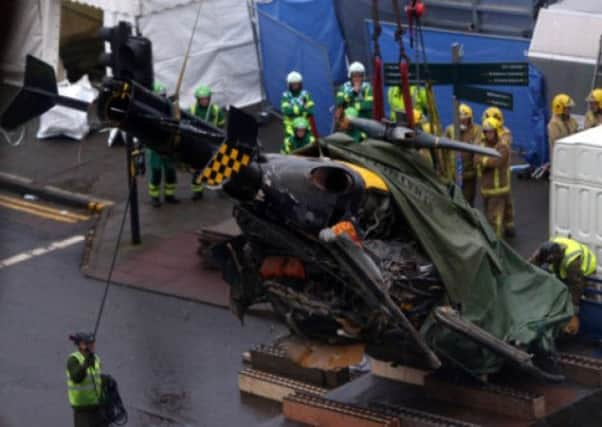Clutha: Helicopter’s engine ‘starved of fuel’


The latest update on the November disaster showed the Eurocopter EC135’s engines cut out despite 76kg of fuel remaining in its tanks.
The Department for Transport’s air accident investigation branch (AAIB) revealed the two fuel supply tanks which linked the main tank to the engines were almost empty, but it has found no problems with the connecting pipes.
Advertisement
Hide AdAdvertisement
Hide AdLawyers for some of the victims said the situation “should never have happened” and the investigation was being hampered by the lack of “black box” flight recorders on such helicopters.
The AAIB said it had established the engines had “flamed out”, or stopped working.
However, investigators still do not know why this happened, and why the pilot did not radio a distress message. The last radar report showed the aircraft at 400ft.
The incident happened shortly before 10:30pm on Friday, 29 November, when the city centre bar beside the River Clyde was packed with more than 100 people watching a band.
The AAIB report said: “The right engine flamed out and shortly after the left engine flamed out.
“The helicopter descended and struck the roof of the Clutha Vaults bar at a high rate of descent, in an upright attitude.
“Evidence indicates that the rotor blades and Fenestron tail rotor were not rotating at the moment of impact.”
The report said the investigation would now “seek to determine why a situation arose that led to both the helicopter’s engines flaming out when 76kg of fuel remained in the fuel tank group”.
Advertisement
Hide AdAdvertisement
Hide AdIt will also look at why no emergency radio transmission was received from the pilot, and why there was no “autorotative descent and flare recovery” - where the pilot attempts to keep the rotors turning by using the force of the air on the blades.
The report said the left fuel supply tank contained 0.4kg of fuel and the right supply tank was empty, with no evidence of leakage during the crash.
However, investigators said a “very close examination” of the fuel system had found that “all paths still permit uninterrupted fuel flow.
“It has also been established that unrestricted flow was also available from each supply tank to the corresponding engine fuel control unit, through the relevant fuel shut-off valves which were found set to the open position.”
The report said the limited data that had been recorded showed low fuel warnings had been triggered, but not the times they had happened.
It said there had been intermittent low fuel warnings for the left fuel supply tank, then a permanent low fuel warning for the right fuel supply tank.
It said: “This was followed by a further temporary low fuel warning, before it became permanent for the remainder of the flight.”
The report said such warnings were triggered when there was some 32kg of fuel left in the left supply tank, and 28kg in the right tank. Pilots are advised to land within ten minutes.
Advertisement
Hide AdAdvertisement
Hide AdThe report said no evidence was found of “foreign object damage”, intake or exhaust blockage in either engine, or of bearing or lubrication system failure.
There was also no sign of structural failure, fire, or damage from a bird or another object hitting the helicopter.
No CCTV recordings had been obtained which captured the end of the flight and the recorded radio transmissions did not contain any reference by the crew to difficulties with the aircraft.
Law firm Irwin Mitchell, which is representing several victims of the crash, said the fuel supply problem was unacceptable.
Jim Morris, a partner in its aviation law team and a former RAF pilot, said: “As there is no indication of problems with the engines, gearbox or flying controls, it appears that a serviceable aircraft crashed due to some form of fuel starvation, despite having 76kg of fuel in its tanks – this is something that should have never happened.”
He said the lack of data from the flight had hampered the investigation, and repeated his call for “black box” flight data recording equipment to be fitted to all passenger helicopters.
A spokesman for the British Airline Pilots’ Association said: “We now know the engines were not running at the time of the crash and it appears this was to do with the fuel system.
“However, pilots, like the AAIB, will not be satisfied until this is explored further and the exact reason for that failure is identified.”
Advertisement
Hide AdAdvertisement
Hide AdA spokesman for helicopter operator Bond said: “This is another step in the AAIB’s systematic investigative process. All concerned understand this process will be a long and complex investigation.
“We continue to support the investigations, and our thoughts remain with all those who have been touched by this tragedy.”
The three people aboard Police Scotland’s sole helicopter were among those who died - pilot David Traill and police constables Kirsty Nelis and Tony Collins.Those killed in the bar were John McGarrigle, 57, Mark O’Prey, 44, Gary Arthur, 48, Colin Gibson, 33, Robert Jenkins, 61, and Samuel McGhee, 56. Joe Cusker, 59, was pulled from the wreckage alive but died in hospital from his injuries almost two weeks later.
A further 32 people were injured, 12 of them seriously.
The AAIB stressed it had not attempted an analysis of the facts in this interim report - known as a special bulletin - which it had published “to provide more factual information and an update on the progress of the investigation”.
SEE ALSO